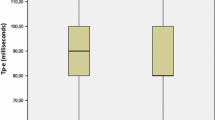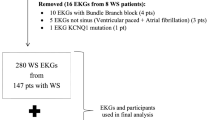Abstract
Reports state that Down syndrome (DS) patients with congenitally normal hearts might experience the development of cardiac abnormalities such as cardiac autonomic dysfunction, valvular lesions, bradycardia, and atrioventricular block. However, the presence of any difference in terms of P-wave dispersion (PWd) and QT dispersion (QTd) was not evaluated previously. This study prospectively investigated 100 DS patients with structurally normal hearts and 100 age- and sex-matched healthy control subjects. Standard 12-lead electrocardiograms were used to assess and compare P-wave and QT durations together with PWd and QTd. The median age of the DS patients and control subjects was 48 months. Heart rates and P-wave and QT dispersions were significantly greater in the DS group than in the control group (113 ± 22.9 vs 98.8 ± 16.6 bpm, p < 0.001; 31.3 ± 9.5 vs 24 ± 8.6 ms, p < 0.001; and 46.6 ± 15.9 vs 26 ± 9.1 ms, p < 0.001, respectively). A positive correlation was found between PWd and age in the DS patients (p < 0.05; r = 0.2). All children with DS should be followed up carefully with electrocardiography in terms of increased P-wave and QT dispersions even in the absence of concomitant congenital heart disease for management of susceptibility to arryhthmias.


Similar content being viewed by others
References
Agiovlasitis S, Collier SR, Baynard T, Echols GH, Goulopoulou S, Figueroa A et al (2010) Autonomic response to upright tilt in people with and without Down syndrome. Res Dev Disabil 31:857–863
Agiovlasitis S, Baynard T, Pitetti KH, Fernhall B (2011) Heart rate complexity in response to upright tilt in persons with Down syndrome. Res Dev Disabil 32:2102–2107
Baynard T, Guerra M, Pitetti KH, Fernhall B (2004) Heart rate variability at rest and exercise in persons with Down syndrome. Arch Phys Med Rehabil 85:1285–1290
Bazett HC (1920) An analysis of the time relations of electrocardiograms. Heart 7:353–370
Bissinger A, Grycewicz T, Grabowicz W, Lubinski A (2011) The effect of diabetic autonomic neuropathy on P-wave duration, dispersion, and atrial fibrillation. Arch Med Sci 7:806–812
Bittles AH, Bower C, Hussain R, Glasson EJ (2007) The four ages of Down syndrome. Eur J Public Health 17:221–225
Blom NA, Ottenkamp J, Deruiter MC, Wenink ACG, Gittenberger-De Groot AC (2005) Development of the cardiac conduction system in atrioventricular septal defect in human trisomy 21. Pediatr Res 58:516–520
Bluzaite I, Brazdzionyte J, Zaliunas R, Rickli H, Ammann P (2006) QT dispersion and heart rate variability in sudden death risk stratification in patients with ischemic heart disease. Medicina Kaunas 42:450–454
Bricout VA, Guinot M, Faure P, Flore P, Eberhard Y, Garnier P et al (2008) Are hormonal responses to exercise in young men with Down’s syndrome related to reduced endurance performance? J Neuroendocrinol 20:558–565
Das BB, Sharma J (2004) Repolarization abnormalities in children with a structurally normal heart and ventricular ectopy. Pediatr Cardiol 25:354–356
de Simone G, Daniels SR, Devereux RB, Meyer RA, Roman MJ, de Divitiis O et al (1992) Left ventricular mass and body size in normotensive children and adults: assessment of allometric relations and impact of overweight. J Am Coll Cardiol 20:1251–1260
Dilaveris PE, Gialafos EJ, Sideris SK, Theopistou AM, Andrikopoulos GK, Kyriakidis M et al (1998) Simple electrocardiographic markers for the prediction of paroxysmal idiopathic atrial fibrillation. Am Heart J 135:733–738
Esbensen AJ, Seltzer MM, Greenberg JS (2007) Factors predicting mortality in midlife adults with and without Down syndrome living with family. J Intellect Disabil Res 51:1039–1050
Fernhall B, Otterstetter M (2003) Attenuated responses to sympathoexcitation in individuals with Down syndrome. J Appl Physiol 94:2158–2165
Fernhall B, Renaud M, Holden H, Slotter C (2000) Autonomic control during exercise is altered in Down syndrome. Sci Sports 15:288
Fernhall B, Baynard T, Collier SR, Figueroa A, Goulopoulou S, Kamimori G et al (2009) Catecholamine response to maximal exercise in persons with Down syndrome. Am J Cardiol 103:724–726
Goldsmith RL, Bloomfield DM, Rosenwinkel ET (2000) Exercise and autonomic function. Coron Artery Dis 11:129–135
Gorlin RJ, Cohen MM, Hennekam RCM (2001) Syndromes of the head and neck, 4th edn. Oxford University Press, Oxford, pp 35–76
Guerra M, Llorens N, Fernhall B (2003) Chronotropic incompetence in persons with Down syndrome. Arch Phys Med Rehabil 84:1604–1608
Hamada T, Gejyo F, Koshino Y, Murata T, Omori M, Nishio M et al (1998) Echocardiographic evaluation of cardiac valvular abnormalities in adults with Down’s syndrome. Tohoku J Exp Med 185:31–35
Hayes C, Johnson Z, Thornton L, Fogarty J, Lyons R, O’Connor M et al (1997) Ten-year survival of Down syndrome births. Int J Epidemiol 26:822–829
Iellamo F, Galante A, Legramante JM, Lippi ME, Condoluci C, Albertini G et al (2005) Altered autonomic cardiac regulation in individuals with Down syndrome. Am J Physiol Heart Circ Physiol 289:2387–2391
Karadeniz C, Ozdemir R, Yozgat Y, Mese T (2013) An unexpected aortic valve in trisomy 21. Am J Med Genet Part A 161:2670–2671
Kistler PM, Sanders P, Fynn SP, Stevenson IH, Spence SJ, Vohra JK et al (2004) Electrophysiologic and electroanatomic changes in the human atrium associated with age. J Am Coll Cardiol 44:109–116
Migliaro E, Contreras P, Bech S, Etxagibel A, Castro M, Ricca R et al (2001) Relative influence of age, resting heart rate, and sedentary lifestyle in short-term analysis of heart rate variability. Braz J Med Biol Res 34:493–500
Nakagawa M, Takahashi N, Iwao T, Yonemochi H, Ooie T, Hara M et al (1999) Evaluation of autonomic influences on QT dispersion using the head-up tilt test in healthy subjects. Pacing Clin Electrophysiol 22:1158–1163
Ozer N, Aytemir K, Atalar E, Sade E, Aksöyek S, Ovünç K et al (2000) P-wave dispersion on 12-lead electrocardiography in patients with paroxysmal atrial fibrillation. Pacing Clin Electrophysiol 23:1109–1112
Pye M, Quinn AC, Cobbe SM (1994) QT interval dispersion: a noninvasive marker of susceptibility to arrhythmia in patients with sustained ventricular arrhythmias? Br Heart J 71:511–514
Raveau M, Lignon JM, Nalesso V, Duchon A, Groner Y, Sharp AJ et al (2012) The App-Runx1 region ıs critical for birth defects and electrocardiographic dysfunctions observed in a Down syndrome mouse model. PLoS Genet 8:e1002724
Roizen NJ, Patterson D (2003) Down’s syndrome. Lancet 361:1281–1289
Sap F, Karataş Z, Altin H, Alp H, Oran B, Baysal T et al (2013) Dispersion durations of P-wave and QT interval in children with congenital heart disease and pulmonary arterial hypertension. Pediatr Cardiol 34:591–596
Seal A, Shinebourne E (2004) Cardiac problems in Down syndrome. Curr Pediatr 14:33–38
Stoll C, Alembik Y, Dott B, Roth MP (1998) Study of Down syndrome in 238,942 consecutive births. Ann Genet 41:44–51
Tran H, White CM, Chow MS, Kluger J (2001) An evaluation of the impact of gender and age on QT dispersion in healthy subjects. Ann Noninvasive Electrocardiol 6:129–133
van der Bom T, Zomer AC, Zwinderman AH, Meijboom FJ, Bouma BJ, Mulder BJ (2011) The changing epidemiology of congenital heart disease. Nat Rev Cardiol 8:50–60
Yavuz B, Deveci OS, Yavuz BB, Halil M, Aytemir K, Cankurtaran M et al (2006) QT dispersion increases with aging. Ann Noninvasive Electrocardiol 11:127–131
Author information
Authors and Affiliations
Corresponding author
Rights and permissions
About this article
Cite this article
Karadeniz, C., Ozdemir, R., Demir, F. et al. Increased P-Wave and QT Dispersions Necessitate Long-Term Follow-up Evaluation of Down Syndrome Patients With Congenitally Normal Hearts. Pediatr Cardiol 35, 1344–1348 (2014). https://doi.org/10.1007/s00246-014-0934-2
Received:
Accepted:
Published:
Issue Date:
DOI: https://doi.org/10.1007/s00246-014-0934-2




